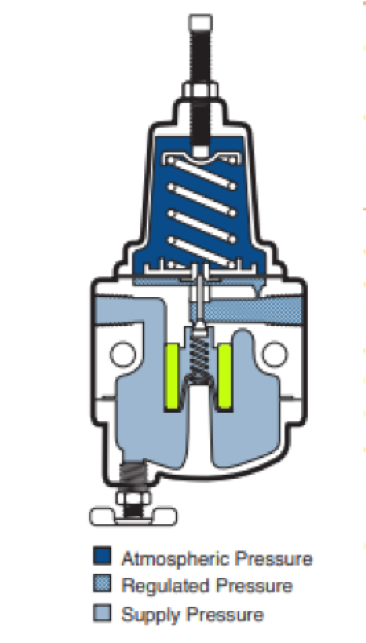Sign up for the ControlAir newsletter.
Get news, updates, and offers direct to your inbox.
Air filter regulators are simpler, inexpensive units that play a crucial role in any pneumatic system. These units accomplish two different purposes at the same time. First, they filter liquids and particulate matter from an air supply. Second, they provide smooth, reliable air pressure to some other process or device in the system. The image below shows a cut-away of the ControlAir Type 300 Air Filter Regulator. The filter, either a 40 micron or 5 micron filter, is highlighted in green to show how supply air is forced through this filter prior to being regulated. The result is well regulated, clean air downstream.

The importance of these types of regulators is based around cost savings in two different ways. More sensitive units, such as I/P Transducers and Valve Positioners, contain components such as small orifice screws, spool valves and circuit boards. Our Type 900, for example, contains an orifice screw that has an orifice size on the magnitude of a few thousandths of an inch. If this orifice were to become clogged with particulates, it would impact the performance of the unit and could potentially result in issues downstream. Dirty air is the most common reason for failure of an IP transducer. By utilizing a filter regulator, you are protecting more sensitive, and likely more expensive, equipment from damage that could result in a costly repair or need to replace the unit.
The second aspect of cost savings involves whatever is happening downstream from the filter regulator. If there is a unit downstream that has an output that will change based on the input pressure into the unit, it is going to be essential to provide stable air supply to such a unit. Air coming directly from a compressor could fluctuate based on the state of the air compressor. If this pressure fluctuation of supply air is changing the output of a downstream unit used in, for example, a plastic extruding application, the end product may not be usable if the process air pressure is too far from the intended set point. By regulating, and filtering, the air coming from a compressor, you are going to be able to provide very stable supply pressure to the unit controlling the process pressure as filter regulators can handle fluctuations in supply air very well. The output of the Type 330 for example will only change by 0.25 PSI for every 25 PSI change in supply pressure into the unit. If a fluctuation like this were to occur, the unit controlling the process pressure would only experience a 0.25 PSI change in the supply pressure being provided to that unit. This 0.25 PSI change in supply pressure is unlikely to have an impact on the output of that unit.
Air filter regulators are an important part of any pneumatic system. They help to provide clean, reliable air supply to your downstream process and act as an inexpensive defender to your more expensive equipment. These two factors will result in less time lost due to repair or failures and great efficiencies from your process.